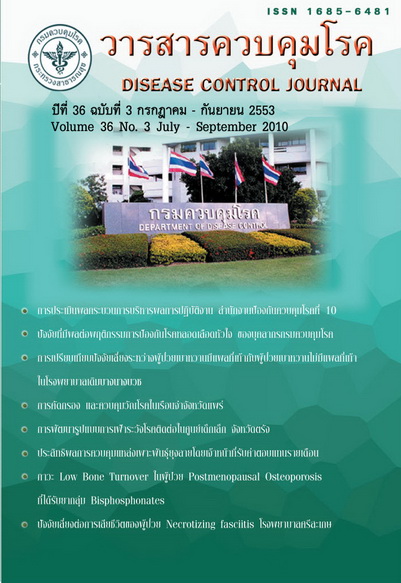Low Bone Turnover in Postmenopausal Osteoporosis with Bisphosphonates Treatment
Keywords:
Bisphosphonates, Osteoporosis, Low bone turnoverAbstract
Low bone turnover in Postmenopausal Osteoporosis with bisphosphonates treatment Bisphosphonates have been widely used and recommended for prevention and treatment of Postmenopausal osteoporosis. They inhibited osteoclast function and promoted osteoclast apoptosis. The inhibition of bone resorption produced a net increase in bone mass in the first or second year of bisphosphonates use. Afterthat, bone cells signal to one another to maintain appropriate resorptionformation coupling. The rate of bone formation eventually decreased to equal that of resorption, leading to an overall reduction in bone turnover. Several reports concerned about oversuppression of bone turnover during long-term use of bisphosphonates might impact to bone fragility. A retrospective descriptive study was done in patients who have continuous treatment with bisphosphonates to determine duration of treatment and low bone turnover status by interpreted bone markers : Beta Crosslaps (CTx), Osteocalcin (OC), Procollagen type I propeptides (PINP) compared with below 1 SD of the mean of healthy premenopausal women. 116 patients were included, age 66.2±9.7 years, body mass index (BMI) 24.0± 4.1 kg/m2. 83 patients were found to have low bone turnover status. The level of bone markers was CTx: 0.07±0.04 ng/ml, OC 6.65±2.56 ng/ml, PINP 12.42±4.07 ng/ml with duration of treatment 20.02±8.23 months. In conclusion, the result showed 71.55% of patients who have continuous treatment with bisphosphonates had low bone turnover status, which 45.78% was found in the treatment duration of 9-17 months.
Downloads
References
2. Delmas P.D., Eastell R., Garnero P., Seibel M.J., Stepan J. The Use of Biochemical Markers of Bone Turnover in Osteoporosis. Osteoporos Int 2000 (Suppl 6):S2-17.
3. Delmas P.D. Markers of Bone Turnover for Monitoring Treatment of Osteoporosis with Antiresorptive Drugs. Osteoporos Int 2000 (Suppl 6) :S66-76.
4. Locker A.C., Bauer D.C., Chesnut III C.H., Gundberg C.M., Hochberg M.C., Klee G., et al. Clinical Use of Biochemical Markers of Bone Remodeling: Current Status and Future Directions. Osteoporos Int 2000 11:467-480.
5. Chailurkit L., Ongphiphadhanakul B., Piaseu N., Saetung S., Rajatanavin R. Biochemical Markers of Bone Turnover and Response of Bone Mineral Density to Intervention in Early Postmenopausal Women: An Experience in a Clinical Laboratory. Clinical Chemistry 2001;47:6 1083-1088.
6. Vasikaran S.D., Glendenning P., Morris H.A. The Role of Biochemical Markers of Bone Turnover in Osteoporosis Management in Clinical Practice. Clin Biochem Rev. 2006; 27: 119-121.
7. Bone HG, Hosking D, Devogelaer JP, Tucci JR, Emkey RD, Tonino RP, Rodriguez-Portales JA, Downs RW, Gupta J, Santora AC, Liberman UA (2004) Ten years' experience with alendranate for osteoporosis in postmenopausal women. N Engl J Med 350:1189-1199
8. Ensrud KE, Barrett-Connor EL, Schwartz A, Santors AC, Bauer DC, Suryawanshi S, et al. Randomized trials of effect of alendronate continuation versus discontinuation in women with low BMD: results from the Fracture Intervention Trial long-term extension. J Bone Miner Res 19:1259-1269.
9. Odvina CV, Zerwekh JE, Rao DS, Maalouf N, Gottschalk FA, Pak CV. Severely suppressed bone turnover: a potential complication of alendronate therapy. J Clin Endocrinol Metab 2005;90:1294-301.
10. Kazuhiro I, Seizo Y, Yorito A, Toshiyuki H 2007 Pelvic insufficiency fracture associated with severe suppression of bone turnover by alendronate therapy. J Bone Miner Metab 25:333-336.
11. Bunyaratavej N Clinical practice in biochemical bone marker. In: Bunyaratavej N, Songpathanasilp T, editors. Bone forum 1. Bangkok: Concept Medicus; 2006:2-8.
12. Bunyaratavej N Clinical practice in biochemical bone marker. In: Bunyaratavej N, Songpathanasilp T, Soontrapa S, editors. Bone forum 2. Bangkok: Concept Medicus; 2005; 49-70.
13. Cheung RKH, Leung KK, Lee KC, Chow TC. Sequential non-traumatic femoral shaft fractures in a patient on long-term alendronate. Hong Kong Med J. 2007; 13(6):485-489.
14. Currey JD (1984) Effects of differences in mineralization on the mechanical properties of bone. Phil Trans R Soc London B Biol Sci 304:509-518.
15. Goh SK, Yang KY, Koh JSB, Wong MK, Chua SY, et al. Subtrochanteric insufficiency fractures in patients on alendronate therapy. The Journal of Bone and Joint Surgery. 2007; 89(3):349-353.
16. Chapurlat RD, Arlot M, Burt-Pichart B, Chavassieux P, Roux JP, Portero-Muzy N. Delmas PD. Microcrack Frequency and Bone Remodeling in Postmenopausal Osteoporotic Women on Long-Term Bisphosphonates: A Bone Biopsy Study. Journal of Bone and Mineral Research. 2007; 22:1502-1509.
17. Bunyaratavej N. Bone markers. In: Narong B Thawee T, eds. Bone Forum. Bangkok: Concept Medical Ltd, 2007:47 (Thai version).
Downloads
Published
How to Cite
Issue
Section
License
Articles published in the Disease Control Journal are considered as academic work, research or analysis of the personal opinion of the authors, not the opinion of the Thailand Department of Disease Control or editorial team. The authors must be responsible for their articles.






